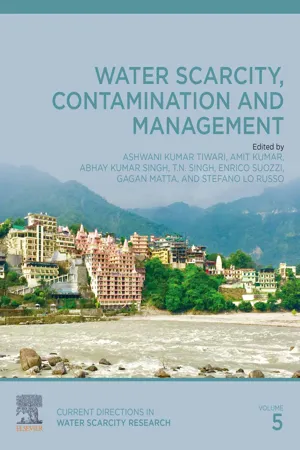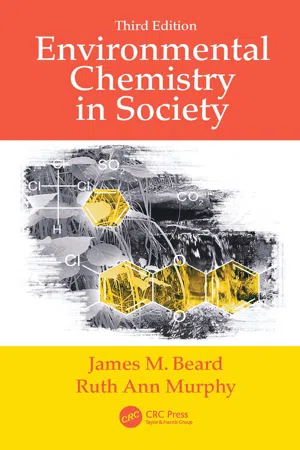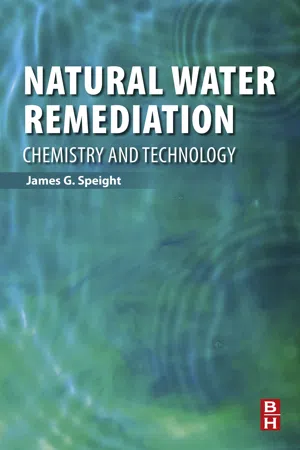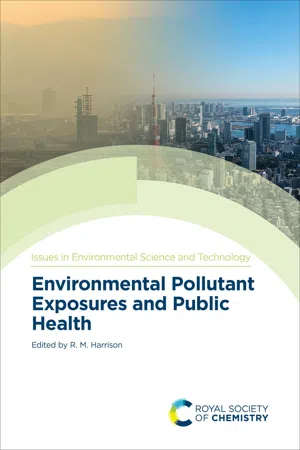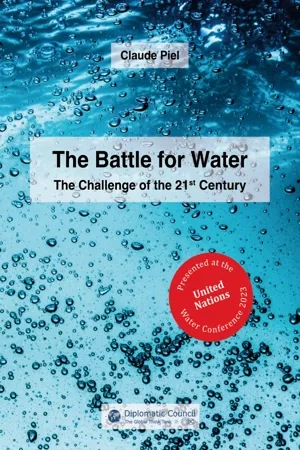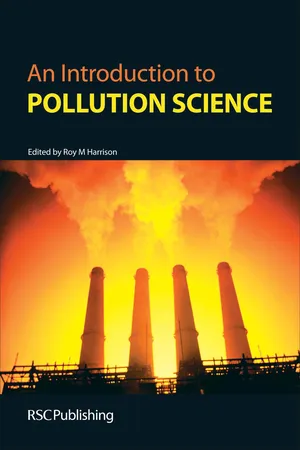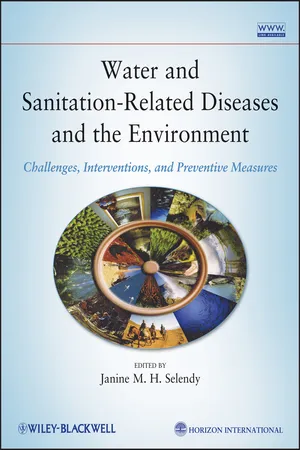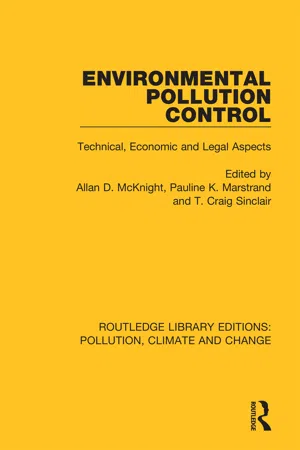Geography
Polluted Water
Polluted water refers to water that has been contaminated by various harmful substances, such as chemicals, microorganisms, or other pollutants. This contamination can occur due to human activities, industrial processes, or natural sources, and it poses significant risks to the environment and human health. Polluted water can have detrimental effects on aquatic ecosystems, wildlife, and communities that rely on clean water sources.
Written by Perlego with AI-assistance
Related key terms
Related key terms
1 of 4
Related key terms
1 of 3
10 Key excerpts on "Polluted Water"
- eBook - ePub
- Ashwani Kumar Tiwari, Amit Kumar, Abhay Kumar Singh, T.N. Singh, Enrico Suozzi, Gagan Matta, Stefano Lo Russo(Authors)
- 2022(Publication Date)
- Elsevier(Publisher)
H , color, hardness, turbidity, DO, BOD, COD, organic and inorganic chemicals, dissolved organic carbon, nutrients, etc.) are the outcome of human activity but certain natural phenomena are liable for the getting worse quality below the required level.According to the Merriam-Webster Dictionary (2019), the term “contamination” is described as the presence of a constituent, impurity or other undesirable element that damages, spoils, infects, makes inappropriate or inadequate the material body, physical, natural environment, and workplace. Water is deliberated contaminated if it contains levels of introduced pollutants that make it unusable or incapable of human use, such as for drinking water, or pollutants that alter its ability to support biological life in it (Sadick et al., 2016 ). Water can also be contaminated from the accumulation of heavy metals and metalloids from rapidly expanding industrial areas, tailings, landfills which dispose with high metal content, leaded gasoline and paints, land fertilization, manure, sewage sludge, pesticides, sewage water irrigation, coal, e-waste, etc. (Sheoran and Sheoran, 2017 ).It is obvious that the pollution of ground and surface waters is a complex and multifaceted process. Pollutants spread over large areas of the aquifer and appear in ground and surface waters after decades and may disappear when they are no longer used (Meybeck et al., 1996 ). Large accidental spills and other point and non-point sources of pollutants cause rapid localized pollution that spreads through water resources. Pollutants that are completely soluble in water and have approximately the same density (for example, wastewater contaminated with chloride) will spread through the aquifer at a rate that depends on the flow rate of groundwater and surface water. Pollutants with a lower density than water will accumulate on the surface of the groundwater and flow over the surface. Dense compounds such as chlorinated solvents will move vertically downward and accumulate at the bottom of the aquifer (Breida et al., 2019 - eBook - ePub
- James M. Beard, Ruth Ann Murphy(Authors)
- 2021(Publication Date)
- CRC Press(Publisher)
Furthermore, the types and concentrations of dissolved materials vary from location to location, making a universal definition of water pollution difficult to come by. Whether water is polluted or not depends to a large extent on what one wants to do with the water. A different level of water quality is required for drinking water than for water used to wash a car or flush a toilet. Generally, we would wish that natural waters are not toxic to the many varieties of aquatic organisms we expect to find in them. Water pollution can be defined as any chemical or biological change that adversely affects the aquatic life normally found in water or that makes water unfit for a desired use. How does water get polluted? The view that most people probably have is of a pipe from some industrial plant discharging toxic stuff into the river. Although this view of the source of water pollution is not unfounded, it is not the entire picture. A significant portion of water pollution comes from rainwater washing across contaminated soil on its way to a river or stream. The source of pollution can be feed-lots covered with manure, heavily fertilized fields, or construction sites. Pollution sources are generally separated into point sources and nonpoint sources. A point source is the discharge of a water pollutant or pollutants from a specific location. A nonpoint source is the generalized discharge of a water pollutant or pollutants from runoff over a large area. 14.2 Types of Water Pollutants Although water pollution is not a new problem, our heavily industrialized society and consumerism, unless restrained, will contribute to its magnitude – and variety. Let’s examine five major categories of water pollutants. 14.2.1 Disease-Causing (Pathogenic) Agents In most of the less-developed countries of the world, the spread of biological agents associated with waterborne diseases is a major problem - J. Senthil Kumar, P. Ponmurugan, A. Vinoth Kanna(Authors)
- 2020(Publication Date)
- Bentham Science Publishers(Publisher)
Water is indispensable for life, and is indisputably the most priceless natural resource that exists on our planet. Living things on the planet cannot live without water. Though we as humans know this fact, we neglect it by polluting our natural resources like rivers, lakes, oceans, and the water beneath the surface of the earth, groundwater. Consequently, we are harming our planet to the point where organisms are vanishing at a very alarming rate. Most of the organisms die, and our drinking water has been prominently affected, as we use water for amusing purposes. It then affects the climate, resulting in consequences such as drought, changes in weather patterns, etc., which have ultimately increased the demand for freshwater. In order to combat water pollution, we must understand the problems and become part of the solution. The change in the chemical and physical properties of water is called water pollution and thus directly or indirectly harmfully affects the living organisms that consume it and render it unfit for the required uses. The water gets polluted through various sources of the organic and inorganic pollutants of Industry, Agriculture, Domestic, Thermal and Biological wastes. Water pollution is a major global problem thatrequires ongoing evaluation and revision of water resource policy at all levels. It has been suggested that it accounts for the deaths of more than 14,000 people daily. In addition to the acute problems of water pollution in developing countries, developed countries continue to struggle with pollution problems as well. In this paper, the sources of water pollution, effects of water pollution on the ecosystem, ways to control pollution and conservation have been described.Keywords: Classification, Health and Environmental Concern, Pollution, Resources, Water.* Corresponding author T. Dhanalakshimi: Department of Biology, Ministry of Education, Republic of Maldives; Tel: 9965664834; E-mail: [email protected]INTRODUCTION
Pollution is the introduction of contaminatants into the natural environment by human activities and causes environmental pollution. The term pollutionrefersprimarily to the entangling of air, water, and land, and is a much more complicated global problem. We, as human beings, are forced to live with contaminated air, water and all sorts of distressing noises. Air and water pollutions are major fatal pollution and can cause the death of many organisms in the ecosystem, including humans. The acute problem in developing and developed countries is water pollution. The damping of an enormous amount of harmful or insufferable matter in water to alter the natural quality of water is called water pollution.Water pollution is the change in the qualities of the water by the presence of surplus physical, chemical or biological substances, which can change the taste, smell and transparent nature of water and is capable of causing harmful effects to the living organisms. The natural or pure water is colorless, odorless and transparent. However, some water pollutants could not be seen or tasted by naked eyes, for example, some chemicals, such as pesticides, and most of the microorganisms that cause water-borne diseases. Contaminated water should not be used for drinking, washing, bathing or agriculture. If Polluted Water is used by humans, then it can adversely affect the body in different ways, depending on the type and concentration of pollutants [1- eBook - ePub
Natural Water Remediation
Chemistry and Technology
- James G. Speight(Author)
- 2019(Publication Date)
- Butterworth-Heinemann(Publisher)
5Sources of water pollution
Abstract
There are many sources of water pollutants for which practical solutions are required to minimize the effects of these pollutants are recent entrants into the environment as well as those pollutants that require remediation (cleaning up) past problems. In the end, there are many choices on the personal level and the societal level that must be made (consciously or not) to decrease the amount of pollution.This chapter presents the various methods by which water systems can be polluted. The effects of water pollution are described varied and include (i) poisonous drinking water, (ii) unbalanced river and lake ecosystems that can no longer support full biological diversity, as well as (iii) deforestation from acid rain. These effects are, of course, specific to the various contaminants.Keywords
Water pollution; Acid rain; Climate change; Effects; Human health; Water-borne disease; Plant life; PhytotoxicityChapter outline- 1 Introduction
- 2 Sources
- 2.1 Acid rain
- 2.2 Agricultural wastes
- 2.3 Alien species
- 2.4 Climate change
- 2.5 Disruption of sediments
- 2.6 Industrial waste and agrochemicals
- 2.7 Nutrient enrichment
- 2.8 Crude oil spills
- 2.9 Radioactive waste
- 2.10 Sewage and oxygen demanding wastes
- 2.11 Thermal pollution
- 2.12 Urbanization
- 3 Effects on specific water systems
- 3.1 Rivers, lakes, and streams
- 3.2 Groundwater
- 3.3 Oceans
- 4 Effects of pollutants
- 4.1 Human health
- 4.2 Water-borne disease
- 4.3 Phytotoxicity
- References
1 Introduction
Water contamination is usually the result of human activity. In areas where population density is high and human use of the land is intensive, groundwater is especially vulnerable. Any activity whereby chemicals or domestic and industrial wastes are released to the environment, either intentionally or accidentally, will pollute a water system. When the water becomes contaminated, it is difficult (sometimes impossible) and expensive to clean up. To begin to address pollution prevention or remediation, it is necessary to understand how water systems interrelate. - R M Harrison, R M Harrison(Authors)
- 2020(Publication Date)
- Royal Society of Chemistry(Publisher)
Mining waste was jettisoned into rivers, as was agricultural waste of all kinds as well as human waste. These approaches worked for a long time until the density of evolving cities and towns reached the point where disposal locations were getting too close to their drinking water sources. It was the discovery of microorganisms that turned water pollution to a public health concern, highlighting illnesses caused through drinking water contaminated with infectious bacteria from sewage. Indeed, even now the bulk of deaths worldwide from Polluted Water arise from waterborne diseases: for instance, contaminated water causes nearly half a million diarrhoeal deaths each year. 1 Although ill-health caused by chemical pollution appears at first glance to be a less pressing issue, there have been major incidents caused both by naturally occurring chemicals and man-made ones. A wide range of chemicals is naturally present in groundwater in varying concentrations from the beneficial to the dangerous, depending on the geology of the underlying rocks, and furthermore human activities have magnified some by altering the pH of the water to make minerals more soluble, mobilised others by digging and altering the soil structure, and added many more directly to surface water, and thence to the marine environment. As a result of these anthropogenic activities, there have been cases where nitrates from agricultural fertilizers have leached into surface waters which were then abstracted as a source of drinking water and have damaged vulnerable new-born babies, causing so-called ‘blue baby syndrome’. 2 Arsenic has extensively polluted groundwater in Bangladesh, where well-meaning international attempts in the 1970s to provide clean water from boreholes have resulted in an estimated 43 000 deaths annually and a threat to up to 55 million people. 3 Naturally occurring fluoride in water also affects the health of local populations who use the water as their water source- eBook - ePub
The Battle for Water
The Challenge of the 21st Century
- Claude Piel(Author)
- 2023(Publication Date)
- Diplomatic Council e.V.(Publisher)
122Pollution of water resources today is characterized by the presence of microorganisms, chemical substances or industrial wastes. It can affect rivers, the groundwater table, brackish waters, but also rainwater, dew, snow and polar ice. As for organic pollution, it comes from the discharge of household plant or animal waste or excrement. These wastes contain bacteria or viruses that can cause microbiological pollution and thus pose a risk to public health. Organic pollution can also result from the dissolution of organic matter in water or from natural phenomena. Chemical pollution is mainly caused by crops and animal droppings: fertilizers (nitrates, phosphates, cadmium), pesticides, herbicides, veterinary drugs and supplements for livestock (copper, zinc), ammonium, nitrogen and phosphorus. Nitrates and phosphates from fertilizers promote the proliferation of algae and bacteria that feed on them, resulting in poor oxygenation. This phenomenon is called "eutrophication of rivers, lakes and coasts." In addition, there are drug-induced micropollutants. Thus, residues of pharmaceuticals are sometimes found in very low doses in rivers, streams or in wastewater from the chemical and pharmaceutical industries, leading to an imbalance in the aquatic ecosystem.Many activities lead to water pollution
Various human activities use tens of thousands of chemicals. Wastewater generated by artisans, traders, health facilities, municipalities, but also by individuals, is the cause of pollution. As for industrial activities, half of them are responsible for organic pollutant emissions (suspended solids, nitrogen and phosphorus products) and for almost all toxic discharges (metals, hydrocarbons, acids, materials) and thus the ecological imbalance due to water heating. In 1978, the French government estimated that 55 percent of the water pollution was caused by industrial discharges. Since then, the installation of wastewater treatment plants in these industries has greatly improved the situation. Here are some examples of pollutants released by small and medium-sized businesses: dry cleaning products, dyeing products, printing solvents, garage lubricants, grooming residues, cleaning residues, detergents, nitrogenous organic substances, and more. Human activities are the main causes of soil degradation and pollution. Agriculture and industry continuously add environmentally toxic substances to soils, but military operations, mass tourism, and garden treatments are also sources of pollution. Soil pollution is the accumulation of various elements (organic or pathogenic) that pose a threat to the soils themselves or to living organisms above a certain threshold.123 - No longer available |Learn more
- Gary S. Thorpe(Author)
- 2023(Publication Date)
- Barrons Educational Services(Publisher)
8Aquatic and Terrestrial PollutionLearning ObjectivesIn this unit, you will learn: ➜Sources of Pollution (water, thermal, air, chemical, etc.) ➜Human Impact on Ecosystems ➜Biodegradable Wastes ➜Groundwater Pollution ➜Water Quality/Water Testing/Water Treatment ➜Bioaccumulation and Biomagnification ➜Types of Waste and Disposal ➜Waste-Reduction Methods ➜Sewage Treatment and Septic Systems ➜Toxicity, Dose-Response Curve, and Pollution and Human Health8.1 Sources of PollutionWater Pollution
Water pollution is the contamination of water bodies, e.g., lakes, rivers, oceans, aquifers, and groundwater. This form of environmental degradation occurs when pollutants are directly or indirectly discharged into water bodies without adequate treatment to remove harmful compounds.Sources of Water Pollution
The following sections describe the various sources of water pollution (Figure 8.1 ).- Point source pollution—release pollutants from known locations, such as discharge pipes, that are regulated by federal and state agencies. Major point sources of wastewater discharge are factories and sewage treatment plants.
- Non-point source pollution—a combination of pollutants from a large area rather than from specific identifiable sources, e.g., discharge pipes. Runoff is generally associated with non-point source pollution, as water is emptied into streams or rivers after accumulating contaminants from specific sources, e.g., parking lots, roads, feed lots, construction sites, agricultural runoff, etc.
Figure 8.1 Source and percentage of ocean pollutants- Thermal Pollution—the degradation of water quality by any process that changes ambient water temperature. A common cause of thermal pollution is the use of water as a coolant by power plants and industrial manufacturers.
8.2 Human Impacts on EcosystemsAir Pollution
As mentioned previously, airborne pollutants can enter water bodies and cause acidification and/or eutrophication. Examples include mercury, which results in higher mercury levels in fish through bioaccumulation and biomagnification, and nitrogen and sulfur oxides, which can lead to water acidification and/or eutrophication. - eBook - ePub
- R M Harrison, R M Harrison(Authors)
- 2015(Publication Date)
- Royal Society of Chemistry(Publisher)
Why then, should we be concerned about water quality? The problem arises through human intervention. Anthropogenic emissions cause contamination of, in particular, supplies of fresh water, which percolate back through the system to potentially affect all ecosystems on the planet. The purpose of this chapter is to investigate which contaminants are important and it concentrates on water contamination by chemicals rather than investigating biogeochemical cycling of pollutants and their ecological effects; topics covered by other chapters within this volume. The task of assessing the relative importance of contamination of the world’s waters is vast, but this chapter, not intending to provide a fully definitive evaluation, will address key areas of concern, their causes and attempts to redress threats.Before the chapter commences, it is worthwhile to consider the relative distribution of water within the global system. Approximately 96% of water on earth is saline, 3% is frozen in the ice caps and glaciers and the remaining 1% is primarily groundwater. Rivers and lakes account for only 0.0001% and 0.01%, respectively. Of the renewable freshwater on a global basis, approximately 8% is withdrawn and used by humans each year (further details are given by Farmer and Graham2 ). Concerns over contamination are generally associated with the precious fresh water resources, transitional (estuarine) waters and coastal locations, which are subject to land-based sources of pollution.Contamination can occur from point sources (for example, domestic wastewater or industrial outfalls) or diffuse sources (such as agrochemical run-off or deposition of atmospheric contaminants). Point sources are comparatively easy to regulate, whereas diffuse sources are usually complex and are more difficult to control. This chapter will address both the types.3.2 STRATEGIES TO ASSESS AND REGULATE POLLUTION
The basic strategy to assess and regulate pollution is exemplified in Figure 1 . The contaminant input with time (flux) is estimated together with the volume of the receiving water, and hence dilution. After accounting for removal processes (such as degradation, sedimentation, etc. – see Figure 2 ), an ambient level can be determined and can be checked through analytical chemistry (monitoring). The critical question is: does the contaminant have a biological/ecological effect (i.e. - eBook - ePub
Water and Sanitation-Related Diseases and the Environment
Challenges, Interventions, and Preventive Measures
- Janine M. H. Selendy, Janine M. H. Selendy(Authors)
- 2011(Publication Date)
- Wiley-Blackwell(Publisher)
Natural pollutants accumulate in waters as a result of physical and chemical processes (e.g., leaching from bedrock), biological processes (e.g., release of metabolic by-products or exuberant growth of harmful algae), or deposition from the air. Natural pollutants can also be present in waters as the result of human activities or man-made systems that expedite the transfer of contaminated water from one place to another (e.g., agricultural waterways). The contaminants listed in this chapter range from elements to complex compounds, from single-celled yeasts to multicellular helminthes, and they have been documented or are implicated in diseases in humans and aquatic flora and fauna.In this chapter, we discuss direct exposures to these contaminants through drinking water and indirect exposures though the contaminants' accumulation in foods, particularly seafood. We also discuss the additional complexity of addressing environmental reality—exposure to mixtures. Finally, we discuss how physical forcers, such as changes in climate and land use, might mitigate or exacerbate the public health impacts of these contaminants.23.2 Natural Pollutants—Chemicals
In this section, we provide a brief overview of the impacts of selected naturally occurring chemical pollutants in water. Additional chapters in this volume provide detailed discussions about arsenic, mercury, dengue fever, soil-transmitted helminths, and malaria, as well as cyanobacteria and cyanobacterial toxins.23.2.1 Inorganic Contaminants
A recent report by the United States Geological Survey provided data collected between 1991 and 2004 on contaminants in private drinking-water wells in the United States (1). The contaminants most often detected at concentrations higher than the human health benchmarks were the inorganic chemicals radon, strontium, arsenic, manganese, nitrate, uranium, boron, and fluoride (1). The health impacts associated with exposure to these contaminants are summarized in Table 23.1 - eBook - ePub
Environmental Pollution Control
Technical, Economic and Legal Aspects
- Allan D. McKnight, Pauline K. Marstrand, T. Craig Sinclair(Authors)
- 2019(Publication Date)
- Routledge(Publisher)
3 ]. However, the trials so far indicate that these may be far more dangerous to ecosystems and to man than phosphates, and a technology for removing them from effluents is not yet developed. Had the antipollution lobby directed its efforts towards enforcing the use of the effluent cleaning technology already available, the final result would have been more satisfactory. For whatever reason, an antipollution lobby seems to be a feature of the developed ‘West’. Notwithstanding its more fantastic prophesies, if this lobby has succeeded in inclining governments to seek and attend to scientific advice about how to enjoy the benefits of technology while minimising the hazards, then it will be worthy of an honoured place in the history of mankind.Types and Sources of Pollution
Pollution is here considered to have occurred when a substance having deleterious effects on one or more aspects of water quality is at large in water as a result of human activity. Substances causing pollution fall into four main categories:- suspended solids,
- highly oxidisable organic waste (BOD),
- metals and other ions,
- soluble organic chemicals.
Some pollutants, for instance iron oxides, fall into more than one category, and all four could be further subdivided, but for present purposes this is not necessary. The activities causing pollution, arranged approximately according to magnitude of effect, are:- 1
- Disposal of domestic waste
- 2
- Food processing Glue manufacture
- Chemical manufacture, including plastics Pharmaceutical manufacture Metal processing
- 3
- Paper making and associated processes
- Slaughtering
- Wool scouring
- Fermentation processes
- Soap and detergent production and use
- 4
- Agriculture and horticulture Forestry
- Retting of natural fibres Wood processing Bleaching and dyeing Laundering
- Gas and coke manufacture
- 5
-
Use and production of radio-active materials [4 , 5 , 6 ]
Of these, all, with the possible exception of wool scouring, retting and coal-distillation gas works, are likely to continue, and to become increasingly aggregated, if current demographic trends continue. Populations will increase and will move into higher concentrations in towns. Industry in these towns will increase in amount and variety and will produce more pollution. In countries such as Britain, Czechoslovakia, Germany, Sweden and the United States with advanced chemical industry, problems associated with the processing of traditional fibres are likely to be overtaken by those associated with the production of synthetics. Broadly, this will mean a change from large quantities of process water discharged with high loadings of oxidisable organic material*
Index pages curate the most relevant extracts from our library of academic textbooks. They’ve been created using an in-house natural language model (NLM), each adding context and meaning to key research topics.
Explore more topic indexes
Explore more topic indexes
1 of 6
Explore more topic indexes
1 of 4
